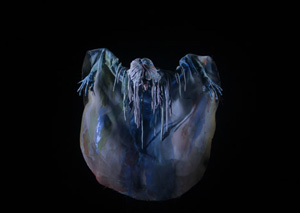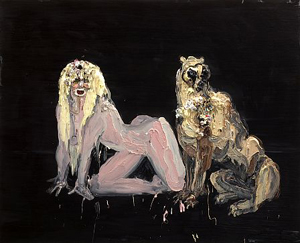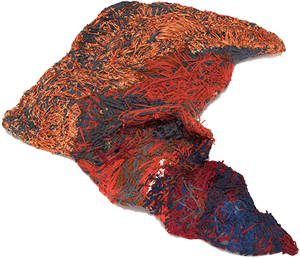Come Outside and Play
John Haberin New York City
Domenico Zindato, Martin Thompson, and Outsider Art
Allison Schulnik and Judith Scott
One fills mad landscapes with birds, snakes, and clashing colors. The other sticks to the grid and to monochrome. Up close to the first, countless eyes stare out from feathers and flowers—or more chillingly on their own. Up close to the second, patterns resolve into countless dots and blank spaces, like artificial intelligence with too much time on its hands. One lives and works in the Americas, the other in an urban environment of bus shelters and coffee shops.
So which is the outsider? I have been describing Domenico Zindato and Martin Thompson, but the question keeps coming up. Allison Schulnik, for one, remembers the ghosts of childhood, but she knows how to haunt others as well. And Judith Scott embraced the urban scene. She worked within its institutions and its strictures, along with the institutions and strictures of illness. With yarn and after yard and thread after thread, she also wraps up some notably insider trends. 
So is there really a single art world, and does that leave almost everyone an outsider? A renewed attention to design, craft, and folk art coincides with a growing suspicion of art's insiders, in upscale galleries and bloated installations. Some have called for abolishing separate displays and fairs for outsider art—or abolishing the term altogether. One might ask instead about its meanings. For Zindato, Thompson, and Schulnik, it merges native traditions and madness with painterly and digital sophistication. Scott's rediscovery, at the Brooklyn Museum, is also about art's responsibilities to its community. Come outside and play.
Outside and in
Oh, sure, everyone is an outsider these days, not just a Southerner like Nellie Mae Rowe, now that collectors lay claim to Art Brut photography and obsessive collecting has become a focus of exhibitions in itself. The term may even comprise such abstract artists as Don Voisine, Pete Schulte, Cary Smith, Mary Bauermeister, and Nathlie Provosty, if not Karla Knight, Jim Shaw and his "Thrift Store Paintings," or Archibald Motley and black southern art as a whole—although the American Museum of Folk Art has looked to New England for black presence and absence. "Simplest Means" pairs them and others sparing of gesture with actual Shaker furniture. Treating craft as nonrepresentational art may sound like formalism, but here one has instead a revisioning of abstraction. The show asserts its relevance to the present, a time of renewed attention to folk art. Consider, then, the distinct senses of folk tradition for Domenico Zindato and Martin Thompson.
Zindato works in Mexico City, but he came to folk art the hard way. Born in 1966, he has lived in Rome and Berlin, with inspiration at each stop along the way. Some of his drawings resemble quilts, although with little patience for repeated patterns. Others run to rolling designs that could stand for flowers, cities, or geological strata, penetrated by them there eyes. His very reliance on drawing lends the painterly colors the crisp edges of folk art, but the interplay between detail and overall composition matters, too. Stepping back and then close again adds to the work's wildness and sense of motion.
Zindato is a long way from the awkward stasis of folk art after all. Even the eyes come off more as sheer exuberance than a haunting. Of the two artists, he also sticks more closely to primary colors, but one would hardly know it from the off-kilter results. And that makes perfect sense, for Thompson does his drawing with fine-point markers, the kind that cannot deliver good old red and blue without a hint of deep purple. Fellow New Zealanders might spot him in public spaces, his ordinary graph paper on his knees, compulsively adding dots. He truly is an outsider in a global economy, forever a stranger in the city.
Born in 1956, Thompson endured near poverty and mental illness, and he exhibited in "Obsessive Drawings" at the American Folk Art Museum in 2006. Up close, the test patterns are clearly handmade, and the impersonality of pixels or a Sol LeWitt wall drawing disappears. LeWitt's mix of order and entropy remains, though, for Thompson sticks to rules as well as to the grid. He works in pairs, from paired dots to paired shapes out of a video game to the division of work as in a diptych into contrasting densities of light and dark. The pairs on different scales never line up, but this is all about broken symmetries.
The artists make strange bedfellows, like Surrealism and Minimalism or the Third World and Silicon Valley. Yet both depend on shifting scale, minimal means, drawing, motion, and compulsion. So which is the outsider? The question is going around for artists everywhere. Zindato's gallery has a reputation for bringing outsider art to Chelsea. Roberta Smith of The Times, who often singles out new work touched by native traditions, has called for fully integrating folk art and Americana into museum displays of past decades, much as another show has claimed outsider art in Switzerland as an inspiration for Abstract Expressionism.
I am not altogether convinced. The Met's American wing adds context and power by keeping the genres apart, while the Brooklyn Museum often loses both by bringing genres together. Still, modern and contemporary art have knocked the distinction out of the park—from Paul Gauguin and Gauguin's prints to street art, Jean-Michel Basquiat, and Michael Stewart. Janet Sobel, whom the Modern keeps excluding both from Abstract Expressionism and displays of the permanent collection, played the outsider while supplying a template for drip painting, and feminism has made craft essential to a recovery of history. In Thompson's most startling drawings, light and dark take on a life of their own, cutting across any trace of the grid. Computer animation has a long way to go to catch up.
Ghosts and clowns
Allison Schulnik was born to Claymation—or at least to modeling clay. Her sculpture runs to ceramics on pedestals, with subjects a child would understand, like a German shepherd or a single flower. Her paintings may seem merely an extension. Their crusty surfaces retain the thickness and imperfections of unfired clay, and the marks of the artist's trowel, brush, or hand could pass for finger painting. She renders her human or inhuman subjects almost life size. In film with much the same cast, she works frame by frame in clay along with fabric and paint, supported by wire, wood, and glue.
Schulnik may have you missing kindergarten, but she does not exactly play well with others. She describes her concerns as chaos and self-absorption. For all her harsh reds and yellows, her dominant color is black. Her painted figures are frightened or frightening to the point of exhaustion. They evoke a solitary child's fantasies of ghosts and clowns. In a sculpture in white, a creature lies curled up and emaciated, and the vultures have departed long ago.
 Talk about beating a dead horse—and enticing you to enjoy it. Still, while that sculpture has an impact that lasts, not everything does. She titles her latest video Eager, and the black dog seems awfully eager to please. Paintings, too, have their over-the-top expressionism. To their credit, backgrounds sop up the light while almost swallowing the sharply etched bodies and faces. Yet you can easily dismiss them as Francis Bacon for kids.
Talk about beating a dead horse—and enticing you to enjoy it. Still, while that sculpture has an impact that lasts, not everything does. She titles her latest video Eager, and the black dog seems awfully eager to please. Paintings, too, have their over-the-top expressionism. To their credit, backgrounds sop up the light while almost swallowing the sharply etched bodies and faces. Yet you can easily dismiss them as Francis Bacon for kids.
Her latest could change your mind. The sheer range of media adds up, including near abstract watercolors of flowers and a dancer with outstretched arms, the medium fitting the translucency of her dress. And Schulnik cites almost a compendium of modern dance as an influence, if not Alvin Ailey, along with Lewis Carroll, Fantasia, and Raggedy Ann. The video then brings together all these images, while bringing the clay to life. As in her previous videos, the characters clump, peel, agonize, reach out, melt, multiply, and transform into flowers, in a plot without a clear beginning or end. Here, though, the LA artist holds out a greater continuity, and her ambiguous ending holds out both a deeper sadness and a more heartfelt relief.
All her animations have the feel of music videos, although Eager runs to eight minutes with an original score by Aaron M. Olson. (She accompanied previous videos with a dance track and Scott Walker's crooning It's Raining Today.) This one spends less time lingering over the size of her cast and the horror of dried, clotted clay. I doubt that I could summarize it, but the melting and withering shapes give way to that veiled dancer in blue, who briefly becomes something like Lear in his madness, before a red flower bursts out from his body. The vegetation becomes an entire forest or garden in synchronized dance, before the sere and solitary figure returns. At the end, he (or she) gives way to another promise or danger lurking within, this time in black.
The multiplicity is exhilarating, as with folk art and blackness for Willie Cole, outsider art out on the streets with Anthony Dominguez, or Morris Hirshfield as a Jew in folk art and Surrealism, and it carries over into the solitary desires and dashed hopes. The imagination has space to run free, and the comedy more genuine. A ghost might belong to trick or treat rather than the living dead. Even the dancer has a funny face. I still worry that a three-year-old child would understand this—and then, like Groucho Marx, I want to add, "Run out and get me a three-year-old child." But for now I refuse to grow up.
Bound to make art
Nearing the end of her life, Judith Scott deposited a hefty dose of her favorite materials, yarn, into a shopping cart missing its front wheels along with goodness knows what else. Then she bound it with still more. It seems obsessive even for her. Did she mean to conjure thoughts of an aging bag lady on the Northern California streets—what many passers-by surely thought of her? Did its forward tilt, as if more than ready to collapse, and its inability to move make her think of herself on turning sixty? Did she even know?
 Scott hardly spoke about her sculpture, even while passing her days with her elbows on a table fashioning it. She left the shopping cart, like all her work, untitled. Nothing indeed seems as far from her as the art world's self-reflective irony. Hers is the epitome of outsider art in all its simplicity and sincerity. It is also hard to picture apart from her, contending with fabric and herself. One can think of her whole life as a struggle to tie things up and to find freedom.
Scott hardly spoke about her sculpture, even while passing her days with her elbows on a table fashioning it. She left the shopping cart, like all her work, untitled. Nothing indeed seems as far from her as the art world's self-reflective irony. Hers is the epitome of outsider art in all its simplicity and sincerity. It is also hard to picture apart from her, contending with fabric and herself. One can think of her whole life as a struggle to tie things up and to find freedom.
The Brooklyn Museum calls her retrospective "Bound and Unbound," and the title applies to her as well. Born in 1943 in Ohio, deaf and with Down syndrome, Scott spent much of a lifetime institutionalized before passing in 1987 into a sister's care in Oakland. There she came upon the Creative Growth Art Center, dedicated to people with disabilities, and started making art. At first she just doodled in colored pencil, its loops broken now and again for collage. Who knows what appealed to her in the bearded face of the surgeon general of the United States, C. Everett Koop? And then the very next year she discovered a handful of twigs, some fibers, and her art.
Now that the mainstream has embraced outsiders like Marcel Storr and James Castle, both in practice and as a model, it is chastening to encounter someone that so completely fits the description. A mental disability, a neglected artist, and an obsessive-compulsive art—check, check, and check. Yet Scott also lacks an outsider's roots in folk art, with all its narratives, concern for detail, and "primitivism." When she adopts human form, it looks less like a totem than a Raggedy Ann doll. She fits with the recovery of women artists and fabric as a medium, but she dissociates yarn and thread from a "woman's work" of modestly knitting and sewing. Her work is gendered, but only obliquely political.
It also fits just fine with fashionable insiders, with all their appropriations and trashy installations. The curators, Catherine J. Morris and Matthew Higgs, have managed forty-five pieces along with drawings, from Scott's very first assemblage to one left unfinished at her death in 2005. The first handful of painted twigs looks obviously tied together, the threads rescuing them their fragility. Soon, though, the bundles take lumpier outlines. Some might hang flat on the wall, although displayed here on shared platforms, while others rest as best they can on the floor. One can only wonder what lies bound within.
Scott relishes color, her looped drawings translating easily into colored thread. She dabbles in representation, from human form to an enormous bird, but much of her work is about its materials—fabric or bare twigs, a shopping cart or a crutch, wire hangers or a table fan, paper towels from a kitchen or toilet, and the hose from perhaps a vacuum. They enter simultaneously as structure and image, with a powerful tension between the two. Bundles may look like spears, tools, or musical instruments, whether they began with one or not. Amid the pleasure of discovering an unknown artist, one can easily overlook how little she has to reveal or to hide. One can relish her familiar objects and lumpen strangeness all the same, but not without acknowledging their limits.

Domenico Zindato ran at Andrew Edlin through January 18, 2014, Martin Thompson at Ricco Maresca through January 18, "Simplest Means" at Jeff Bailey through February 15, and Allison Schulnik at ZieherSmith through February 22. Judith Scott ran at The Brooklyn Museum through March 29, 2015.




